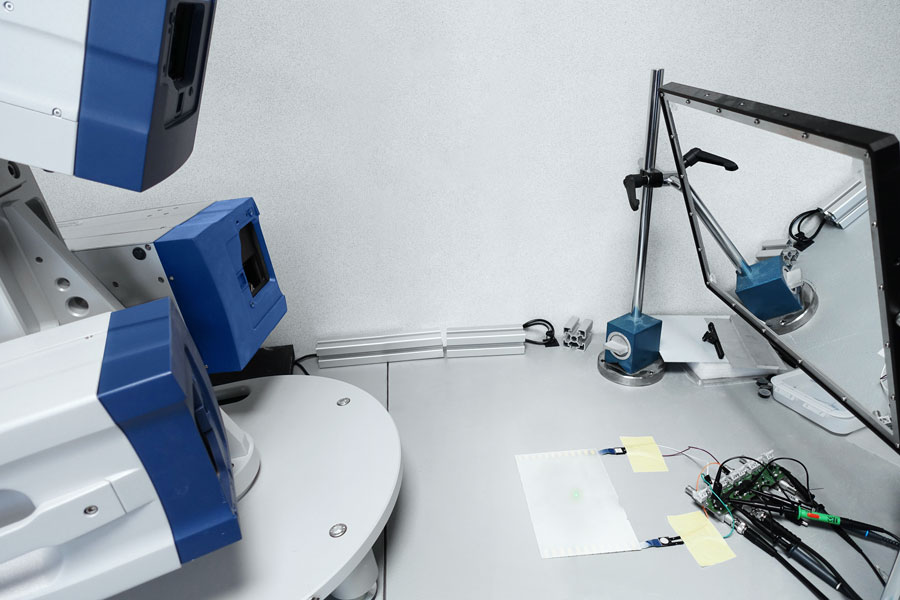One of the things we do at Polytec is solving #VibrationMeasurement problems that our customers thought were impossible before talking to us. There are a whole host of reasons why traditional methods, such as using accelerometers, might not be possible for an application.
We've put together some examples of why you may not have been able to measure vibration until now and some applications where #vibrometers have been used successfully.
Out of reach?
There may be something you want to measure regularly, but permanent contact measurement is either too costly or impractical. This might be because of distance or because of obstacles in the way.
It could be lighting in a concert venue because of the height and expense of adding a continuous monitoring system. It could be pylons where it would be better to measure from a distance without having to turn the power off and send someone up.
It could be a wind turbine blade, where continuous monitoring is impractical because it rotates (see moving below), and you cannot send someone up to measure the vibrations while it is rotating – making it impossible to check while in use without a non-contact method.
Behind glass or underwater?
Objects vibrate differently underwater, so it is better to measure in its usual environment, for example, a ship propeller. Sometimes in medical research, you might want to measure a product in a liquid – for example, ultrasound equipment.
Sometimes you need to measure something that has to be behind glass for safety reasons. For example, engine testing in aerospace, climatic chambers in academic research, or a vacuum for testing satellites.
Under extreme temperature?
You may need to measure something under extreme temperature (extreme cold, extreme heat or even variable extremes). This means that contact measurements are impossible.
For example, climatic chambers, cryogenic coolers, and MRI scanners (also see under magnetic below).
You may have to measure something exposed to extreme heat during manufacture or operation — for example, jet engines or exhaust systems.
Magnetic?
Some very magnetic objects can interfere with the sensor readings of accelerometers or, in extreme cases, even damage them.
Certain objects create magnetic fields so strong that nothing metallic can be in their vicinity while in operation. An example of this is an MRI scanner.
Radioactive?
In most cases, you do not want to go anywhere near a radioactive source – and anything that comes into contact (including sensors) could be contaminated and become nuclear waste. Even if they are not left contaminated, radiation can damage sensors. In any case, you do not want to use contact sensors directly on a radiation source!
Moving?
Moving objects also come with challenges when measuring vibration. The issue is that traditional sensors need cables to operate. If you are dealing with something that rotates (such as the wind turbine blade above under "out of reach), measuring the vibration while it isn't something that can be done using traditional methods.
Applications, where you may want to measure the vibration of something rotating, include drive shafts, jet engine blades, tires on a moving car, etc.
Too lightweight or fragile?
Many structures are made of composite materials – often very lightweight – so if you physically attach something, it can change the composition and, therefore, the response (the observer effect), meaning using direct contact sensors, is not an option.
You might want to measure something tiny or fragile – with vibrometry, you can even measure something as small as a bumblebee's antennae! Far too small to measure using traditional methods!
Too high a frequency?
You may want to measure the vibration of something in operation that runs at a very high frequency. Most sensors use a mechanical method which limits the possible physical response. Vibrometers use light and do not have the same limitations.
Examples of high-frequency applications include MEMS (Microelectromechanical systems) – such as those in mobile phones and electric motors – which sometimes operate at too high a frequency for other methods. Vibrometers can measure objects operating at up to a frequency of 6GHz!
Not enough time?
Testing the vibration of some objects can be very time-consuming – especially if you have many points to measure or many objects to measure. With vibrometry, if you make the same measurement on many objects multiple times, you can go from low to very high resolution with minimum time input.
For example, end-of-line processes in manufacturing. Vibrometers have been used to measure the ripeness of avocadoes. They've also been used in bearings manufacturing to check their friction. Doing this manually or with contact sensors would be incredibly time-consuming.
Unusual surface?
There are all sorts of surfaces that make direct contact sensors unsuitable.
For example, you may have a surface that would be damaged by direct contact, such as a liquid-coated surface.
You may have a surface that behaves in an unusual way which is impacted by direct contact, such as metamaterials or auxetics (materials that, when stretched, become thicker perpendicular to the applied force).
Increasingly structures are designed with curved surfaces, which also causes issues when measuring with an accelerometer as they need to be attached to a flat surface.
If you have a vibration measurement problem and want to know if vibrometry is the answer, contact our UK team on 02475 267 020 or at info@polytec-ltd.co.uk
